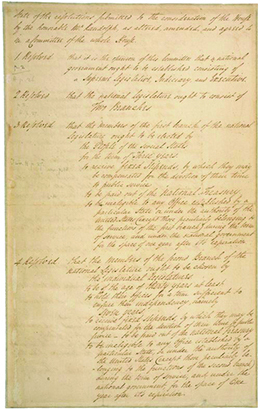| << Chapter < Page | Chapter >> Page > |
One issue that the delegates in Philadelphia addressed was the way in which representatives to the new national government would be chosen. Would individual citizens be able to elect representatives? Would representatives be chosen by state legislatures? How much representation was appropriate for each state?
James Madison put forward a proposition known as the Virginia Plan , which called for a strong national government that could overturn state laws ( [link] ). The plan featured a bicameral or two-house legislature, with an upper and a lower house. The people of the states would elect the members of the lower house, whose numbers would be determined by the population of the state. State legislatures would send delegates to the upper house. The number of representatives in the upper chamber would also be based on the state’s population. This proportional representation gave the more populous states, like Virginia, more political power. The Virginia Plan also called for an executive branch and a judicial branch, both of which were absent under the Articles of Confederation. The lower and upper house together were to appoint members to the executive and judicial branches. Under this plan, Virginia, the most populous state, would dominate national political power and ensure its interests, including slavery, would be safe.

The Virginia Plan’s call for proportional representation alarmed the representatives of the smaller states. William Paterson introduced a New Jersey Plan to counter Madison’s scheme, proposing that all states have equal votes in a unicameral national legislature. He also addressed the economic problems of the day by calling for the Congress to have the power to regulate commerce, to raise revenue though taxes on imports and through postage, and to enforce Congressional requisitions from the states.
Roger Sherman from Connecticut offered a compromise to break the deadlock over the thorny question of representation. His Connecticut Compromise , also known as the Great Compromise, outlined a different bicameral legislature in which the upper house, the Senate, would have equal representation for all states; each state would be represented by two senators chosen by the state legislatures. Only the lower house, the House of Representatives, would have proportional representation.
The question of slavery stood as a major issue at the Constitutional Convention because slaveholders wanted slaves to be counted along with whites, termed “free inhabitants,” when determining a state’s total population. This, in turn, would augment the number of representatives accorded to those states in the lower house. Some northerners, however, such as New York’s Gouverneur Morris, hated slavery and did not even want the term included in the new national plan of government. Slaveholders argued that slavery imposed great burdens upon them and that, because they carried this liability, they deserved special consideration; slaves needed to be counted for purposes of representation.

Notification Switch
Would you like to follow the 'U.s. history' conversation and receive update notifications?